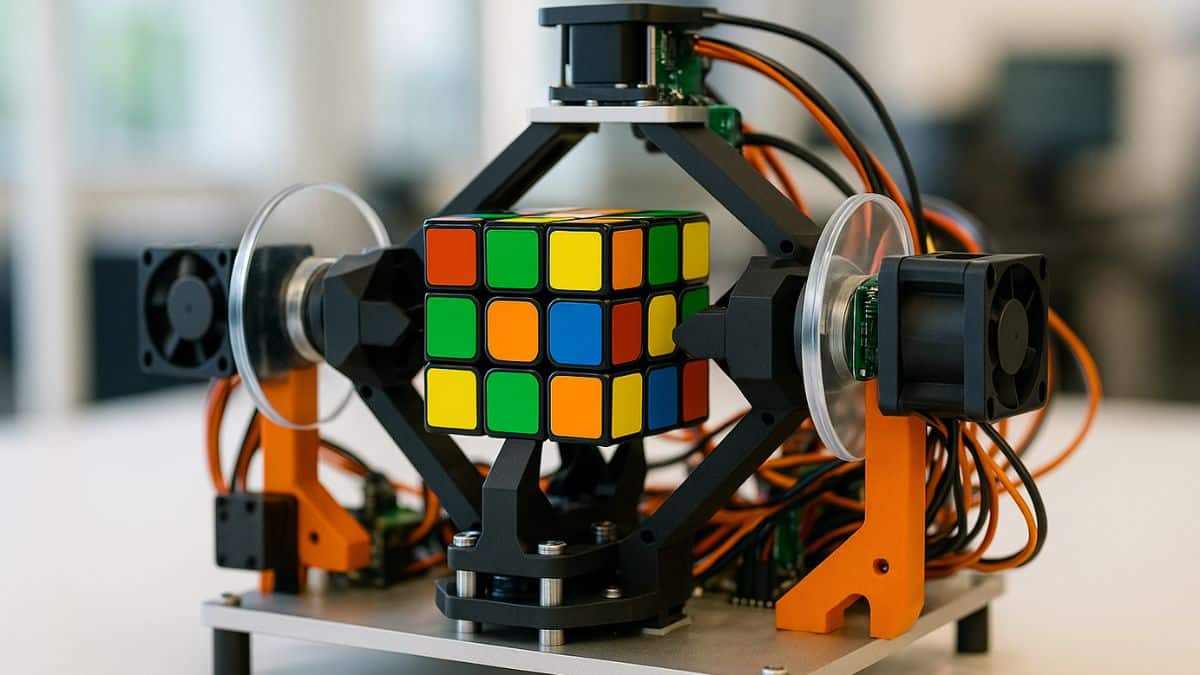In a groundbreaking achievement for robotics and artificial intelligence, students from Purdue University have shattered the world record for solving a Rubik’s Cube with their lightning-fast robot. The team’s creation, named “Purdubik’s Cube,” completed the colorful puzzle in just 0.103 seconds—faster than a human can blink.
Engineering marvel: breaking the speed barrier
The Purdue University engineering students have redefined what’s possible in high-speed robotics with their record-smashing cube-solving machine. Their creation demolished the previous Guinness World Record of 0.305 seconds set by Japanese engineers in May 2024, nearly tripling the solving speed.
Team member Matthew Patrohay put the achievement in perspective: “We solve in 103 milliseconds. A human blink takes about 200 to 300 milliseconds. So, before you even realize it’s moving, we’ve solved it.” This sub-blink speed performance showcases the extraordinary capabilities of modern robotics when combined with innovative engineering.
The project emerged from Purdue’s Elmore Family School of Electrical and Computer Engineering (ECE), where the students first unveiled their creation at SPARK, the university’s student design competition. After securing first place in December 2024, the team continued refining their robot to push beyond existing limits of speed and precision.
The technological components making this feat possible include:
- Advanced machine vision systems for instantaneous color detection
- Custom-developed solving algorithms optimized for speed
- Industrial-grade motion control hardware from Kollmorgen
- Sub-millisecond synchronization capabilities
- Bluetooth-enabled “Smart Cube” for real-time puzzle scrambling
Technology behind the lightning-fast solution
The record-breaking robot system represents a perfect marriage of hardware precision and software intelligence. Each component was meticulously designed to work in harmony, creating a machine capable of processing information and executing physical movements with unprecedented speed.
The system’s architecture involves multiple synchronized processes operating simultaneously. When a scrambled cube is placed in the machine, high-speed cameras instantly capture and analyze the color pattern. The custom algorithm then calculates the optimal solution path in milliseconds before the mechanical components execute the required moves with surgical precision.
| Component | Function | Contribution to Speed |
|---|---|---|
| Machine Vision System | Color detection and pattern recognition | Instantaneous cube state analysis |
| Custom Algorithms | Solution path calculation | Optimized move sequence generation |
| Kollmorgen Hardware | Physical cube manipulation | Ultra-precise mechanical execution |
| Control System | Coordination of all components | Sub-millisecond synchronization |
Shreyas Sundaram, Marie Gordon Professor of ECE at Purdue, emphasized the achievement’s significance: “The Purdubik’s Cube team is a prime example of how Purdue is bringing algorithms, robotics, and control together to achieve great feats of engineering.”
Implications for future robotics applications
This breakthrough extends far beyond solving puzzles. The ultra-fast precision demonstrated by Purdubik’s Cube points toward revolutionary applications across multiple industries. Nak-seung Patrick Hyun, assistant professor at Purdue, noted: “This achievement isn’t just about breaking a record; it pushes the boundaries of what synthetic systems can do. It brings us closer to understanding ultra-fast coordinated control systems like those found in nature.”
The technologies developed for this project could transform fields requiring split-second precision and complex problem-solving, including:
- Medical robotics for microsurgery and diagnostic procedures
- Manufacturing automation requiring ultra-precise movements
- Search and rescue operations demanding rapid assessment and response
- Next-generation consumer electronics with enhanced responsiveness
The project also highlights the power of educational initiatives like Purdue’s Cooperative Education Program, where students develop both technical expertise and collaborative skills. These real-world engineering experiences prepare students to tackle complex challenges while pushing technological boundaries.
As robotics continues evolving, achievements like the Purdubik’s Cube demonstrate how human innovation can create machines that perform tasks beyond our biological capabilities. While humans may never match this robot’s solving speed, the technology represents our collective ingenuity and points toward an exciting future where human creativity and machine precision work in tandem to solve increasingly complex problems.







